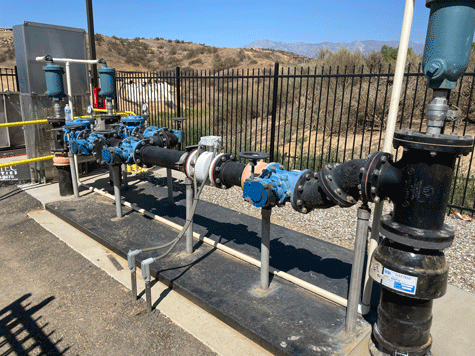
The hot, southern regions of the United States and especially Southern California provide ample opportunities for building above-grade valve and flow meter assemblies for submersible wastewater pump stations.
The city of Beaumont, California, has a residential community called Fairway Canyon under development that features golf courses, parks, a clubhouse and views of the nearby mountains. The community sits on 985 acres with 3,300 residences, 50 acres of parks and four miles of trails. The balmy year-round climate in Southern California allowed the developer to install an interim wastewater packaged pump station that incorporated the use of an above-ground valve and manifold system. This was a requirement by the city of Beaumont for this project and is common in Southern California where there is no risk of freezing.
The developer partnered with a pump station design and supplier to commission the Phase 4 system for the Fairway Canyon development.
“I don’t have the frost warnings, which are common in Southern California,” said Michael Hughes, the general superintendent. “Which was a big help for these temporary pump stations when you don’t have the time to build the fully enclosed building.”
Because of the warm, year-round weather and temporary use of the station, there was no control building needed. Instead, the motor control center is housed in a steel enclosure. The pump station has good lighting, a good fence and a scenic golf course right next to it.
There can be drawbacks to putting the valves into an underground vault from a maintenance standpoint. When pumps get clogged or check valves get debris in them, it can be hard to access and fix efficiently.
The above-ground manifold system allows the above-grade disconnect, discharge line, valves and piping to be easily accessed. The interim nature also allows for easy equipment removal when the time comes to switch over to a different system, although the system may continue to be on board for many years.
“If everything was below ground, we would have to take the valve system out, and it would be harder and take longer,” Hughes said. “It’s easier to get the temporary lift station decommissioned without causing more damage to the street area or the sidewalk.”
The pump station was designed to meet Beaumont’s standards, which adopted Eastern Municipal Water District (EMWD) requirements. This included the generator and exhaust meeting the EMWD standards, which called for a diesel particulate filter.
Generators typically must also be housed inside buildings in the northern states, but this generator was able to keep the reliability and functionality of diesel outdoors. Because the Phase 4 lift station is temporary, some concessions were made. For instance, it is a six-foot diameter well instead of eight feet that extends to 24.75 feet in depth.
The station is temporary because the development is large. To continue progress on houses in the first few phases, this pump station was installed about halfway down the hill. Ultimately, a pump station will be installed at the lowest point in the development that will be permanent and fully meet Beaumont’s standards.
The station uses pumps with impeller technology and a mix flush valve. These impellers are solids handling impellers that also have a cutting groove. This cuts longer materials, preventing them from wrapping around the impeller and clogging the pump. However, it is not considered a true cutter pump.
The mix flush valve directs a portion of the pumped fluid toward either the basin floor or water surface, depending on which direction the port is aimed. This breaks up fats, oils and greases (FOG) on the surface or resuspends solids on the floor, which the pump can then remove.
An ultrasonic transducer is used for primary-level sensing. This sound-based transducer is installed above the water level. Floats are used for backup level sensing that uses float switches with gold-plated contacts which allow reliable electrical contact at low voltages.
The disconnect incorporates the use of plugs and receptacles that are rated for an active disconnect and a means for a quick disconnect. This way, a certified electrical technician is not required to terminate the wires of the pumps. The pump station uses an electromagnetic flow meter. The probes in the water are stainless and smooth to prevent corrosion or the gathering of foreign objects.
“The technology in place is used by a contractor to monitor it remotely. So, if something does come up, they can get out there to get it fixed quickly by getting notified on their phone,” Hughes said.
The Phase 4 interim submersible wastewater pump station is an example of adjusting to the project’s needs to continue to make the development successful as it grows. For those places in the warmer, southern region of the United States, avoiding the control structure and building an above-grade valve system provides upfront cost and continuous maintenance benefits.

